All the goods and merchandise travelling by container will not only reach their destination late but prices will now reflect increased costs. This will mean higher prices on shelves which, in turn, will lead to an overall increase in inflation, Osama Rizvi writes.
As the UK and US target Houthi sites, tensions are rising in the Red Sea and bringing the possibility of a full-blown crisis that could threaten the global economic recovery.
In such a scenario, Europe and its people can expect to face higher energy costs, delayed shipments, and a return of inflation resulting in higher and longer-lasting interest rates.
All of these developments spell more trouble for the average consumer and local businesses.
The problems began when the Yemeni group started to target commercial ships as a result of the ongoing Israel-Hamas conflict in the Middle East. As of now, the Houthis have launched dozens of attacks on ships crossing the important international maritime pathway.
The UK and US launched an air offensive in retaliation, with US President Joe Biden ordering the strikes "in direct response to unprecedented Houthi attacks against international maritime vessels in the Red Sea". Coalition forces have targeted more than 16 cities and struck 60 targets, according to official reports.
The involvement of US, UK and coalition forces has turned what was a regional crisis into a global one. The US has blamed Iran for providing support to the Houthis.
If this development escalates further then the global economy, including that of the EU, stands to suffer significant losses.
Europe may be hit with higher energy prices
Oil prices have already risen as a result of the tension, with Brent hitting the psychologically important mark of $80 (€73.12).
The Red Sea accounts for 12% of global seaborne oil trade, and 8% of liquefied natural gas (LNG).
The amount of crude oil passing through the Suez Canal has increased by 60% since 2020, as Europe has registered a rise in demand from pandemic lows.
Additionally, Europe has been importing oil from the Middle East producers through the Suez Canal since the EU imposed sanctions on Russia because of the conflict in Ukraine.
According to freight data analyst Vortexa, a detour resulting from Red Sea disruptions could lead to a 58% to 129% rise in the length of time it usually takes oil tankers to travel through the world's main routes, including India to Europe and the Middle East to Europe.
The timing could not be worse, particularly as winter starts to bite in Europe, with potential disruption in energy supply which might directly affect households.
Supply chain disruptions
More than 15% of global shipping traffic passes through the Red Sea, making it one of the most important strategic waterways in the world.
Some 123.5 million metric tonnes of goods were exchanged via the Red Sea and more than 22,000 ships passed it in 2022, latest figures report. Overall, a whopping 12% of global trade volumes use this trade route.
However, because of the disruption, the world's shipping businesses' containers are using the longer route, avoiding the Red Sea and going around the Cape of Good Hope.
This is resulting in a surge in shipping rates as the cost per container has risen to between $5,000 (€4,570) and $8,000 (€7,312) which is two to five times more than the normal rate for this time of the year.
Additionally, the detour is adding around 10 days or 3,500 nautical miles to the usual distance, further increasing insurance premiums. According to the container rate database Xeneta, there has been a 124% increase in freight rates between the Far East and North Europe.
As a result, all the goods and merchandise travelling by container will not only reach their destination late but prices will now reflect increased costs. This will mean higher prices on shelves which, in turn, will lead to an overall increase in inflation.
Inflation and continuing high-interest rates
According to Allianz Trade, the disruptions could result in a 0.7% increase in inflation for Europe which could further delay a rebound from a severe economic slowdown in the region.
This could also force the European Central Bank (ECB) to keep the interest rates higher for longer so that its efforts so far to fight inflation do not lose momentum. The ECB has raised rates 10 times in consecutive hikes.
Higher interest rates can put downward pressure on businesses and also discourage further economic activity — something that has already been muffled throughout 2023 as indicated by the eurozone PMI which stands at 43.8, suggesting production dropped for eight consecutive months.
The outlook for European inflation has improved recently but there is still a long way to go. In Germany, the Consumer Price Inflation (CPI) was up 3.8% in December, higher than 2.3% in November.
France also registered an increase in CPI which stood at 4.1% in December against November's figure of 3.9%.
An increase in energy prices and supply chain disruptions is likely to add to the current economic concerns for European countries, meaning that the tensions in the Red Sea may carry serious consequences for Europe in particular and the world in general.
Osama Rizvi is an economic and energy analyst with a focus on commodities, macroeconomy, geopolitics, and climate change.
At Euronews, we believe all views matter. Contact us at view@euronews.com to send pitches or submissions and be part of the conversation.


















